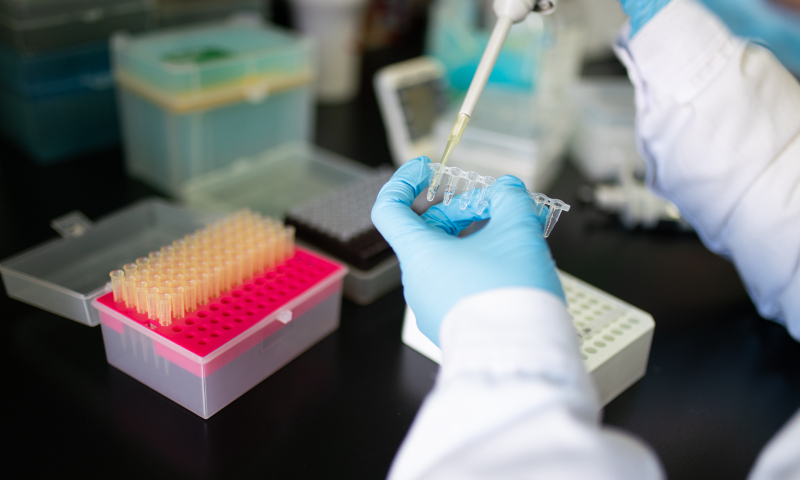
COVID-19 testing Photo: VCG
Chinese social media platforms have recently seen a rise in posts of COVID-19 reinfections, sparking concerns over a potential resurgence of the virus. Chinese experts suggested that although positive cases have increased in July compared to the previous month, the rise is within normal fluctuation ranges and will not place a significant strain on the country's healthcare system.
Data released by the Chinese Center for Disease Control and Prevention (China CDC) on Thursday showed that a total of 7,042 local COVID-19 infections were reported in July, all of which belong to the Omicron variant. Compared with June, there is a slight increase of 767 positive cases.
The World Health Organization (WHO) also warned on Tuesday a worldwide surge in COVID-19 infections, including at the Paris Olympics, saying the surge is "unlikely to decline anytime soon."
According to the Chinese CDC, data monitoring suggests that the number of total fever cases decreased from 125,000 on July 1 to 92,000 on July 31, which is significantly below the peak typically seen during the autumn and winter months. Additionally, the percentage of flu-like cases in nationwide hospitals also experienced a drop in July.
Huashan Infection, the official WeChat account of Huashan Hospital of Fudan University, said in a report on Saturday that among patients under 14 years old, mycoplasma pneumoniae is the most commonly detected pathogen, with the novel coronavirus coming in second. While in patients aged 14 and older, novel coronavirus is still the most frequently detected pathogen.
These data suggest that while the proportion of influenza and other viral infections has decreased in the summer, COVID-19 cases have risen, the report said.
As the virus continues to evolve and spread, there is a growing risk of a more severe strain of the virus that could potentially evade detection systems and be unresponsive to medical intervention, the WHO warned on Tuesday.
Since early June, XDV.1 and KP.2 series of the Omicron variant have been detected at higher rates, with XDV.1 rising to 40-50 percent of cases. However, these variants have not led to a rise in severe cases, as shown by Chinese CDC data.
The number of severe cases in July stood at 203, lower compared to February and March, which saw 358 and 588 severe cases respectively.
Zhang Wenhong, China's renowned infectious disease expert, reassured the public in the report on the WeChat account of Huashan Hospital of Fudan University that COVID-19 infections globally are entering similar fluctuation patterns. For instance, in the US, there have been three waves of COVID-19 since August 2023, with cycles roughly every 5-6 months, showing no significant upward trend since 2022, similar to the situation in China.
These cyclical fluctuations are linked to variant mutations and changes in human immunity, Zhang said.
Lu Hongzhou, head of the Third People's Hospital of Shenzhen, also observed a similar situation at his hospital, where the positivity rate of COVID-19 has increased since July, accounting for about 20 percent of patients presenting symptoms.
Among these patients tested positive for COVID-19, around 10 percent need to be hospitalized, most of whom are elderly patients with underlying health conditions, Lu told the Global Times on Sunday.
According to Lu, climate has a significant impact on the transmission of influenza and other respiratory viruses, which display noticeable seasonality. However, based on existing data, climate has a minimal effect on the transmission of COVID-19, and there is no clear seasonality associated with the virus.
Lu deduced that the high transmission rate of COVID-19 during the summer may result from factors such as increased movement and gatherings of people, virus mutations, relaxed prevention measures, and indoor environments.
"The increasing social activities and travels during the summer days has increased opportunities for viral transmission. Hot weather may lead to a relaxation of preventive measures like wearing masks. Some indoor venues with prolonged closure condition and poor ventilation due to the heat, further increase the risk of transmission," Lu said.
Lu added that the antibody levels in the body will gradually decrease over time, which may lead to reduced immunity against the COVID-19. Increased movement and gatherings during the summer travel peak, as well as factors such as environment and individual immune status, may also have an impact on the spread of the virus.
Monitoring of the three COVID-19 waves from May 2023, August 2023, and into February 2024 shows that, due to ongoing mutations and periodic immune waning, COVID-19 is becoming similar to influenza and other respiratory diseases, with its severity remaining relatively stable.
Currently, the COVID-19 infection surge in July is part of an upward trend, but overall, the number of cases remains lower compared to the peak in autumn and winter of last year, suggesting no significant strain on healthcare resources or the population, the expert noted.
Lu suggested that vaccination against COVID-19 can effectively reduce the risk of severe illness and death after infection and enhance immunity against the virus since COVID-19 continues to mutate, despite that the overall situation is relatively stable, there remains a risk of localized outbreaks and small-scale epidemics.




